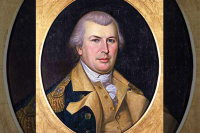Rags to riches: Unlocking the value of antiques rarely results in a jackpot
 Lake Junaluska resident Hattie Polk finally inched her way to the front of the line and released her clutch on what she believed to be an English monastery lantern dating to the reign of King Henry VIII, circa late 1800s — proudly offering it up to the antique appraiser with a glimmer in her eye.
Lake Junaluska resident Hattie Polk finally inched her way to the front of the line and released her clutch on what she believed to be an English monastery lantern dating to the reign of King Henry VIII, circa late 1800s — proudly offering it up to the antique appraiser with a glimmer in her eye.
The lantern was hand-forged brass with a slinky-like waxed paper held between the base and the top. After the serving the monks, according to Polk, the lantern eventually landed in the hands of man who ran a way station in the early West. From there it made its way to a family friend and then Polk’s brother who gave it to her.
But the antiques expert stopped Polk at “way station in the early West.”
“Now it’s getting a little strange don’t you think?” Bob Ruggiero said.
Instead, Ruggiero dated the collapsible lantern to sometime in the 1800s and estimated it may be worth $100 or so in the hands of the right collector.
Related Items
Whether Polk believed him, or preferred to stay with her magical story of 15th century monks, was up to her. But Ruggiero has spent decades dishing out hard truths about people’s heirlooms and prized possessions. As the antiques market as a whole has been on a steady decline, those truths have become harder of late.
“It’s going to be hard to sell with the chip, so pass it on to the kids,” Ruggiero said to another woman who approached with a jug he surmised stored either vinegar or moonshine. Without the chip he tossed out a value anywhere between $250 and $500 for the antique container.
But, being the “bearer of bad news,” as he puts it when someone is brought back down to reality by one of his assessments, is part of the business, and is the fairest way to treat someone seeking his honest advice.
Ruggiero’s career brought him from an education in finance at the Ivy-league University of Pennsylvania to the auction blocks of Sotheby’s in New York before eventually settling in the rural Haywood community of Fines Creek and working for the Brunk Auctions firm in Asheville.
Last Saturday, Ruggiero hosted a drop-in antique appraisal session at Lake Junaluska, one of many special events that filled a week-long celebration of Lake Junaluska’s Centennial. Like a local version of the popularized Antique’s Roadshow, Ruggiero fielded a steady stream of mostly senior women baring their sacred antiques.
For every handful of worthless China sets and chipped vases there were a few diamonds in the rough, except, sometimes they are hard to spot.
Sara Crump and her husband Ed, who live at Junaluska part-time, brought three things with them to have Ruggiero take a look at — a hand-woven rug they bought in Israel, a large print of a jockey on a horse and a small painting of an Appalachian homesteader family.
Ruggiero valued the horse print between $300 and $500, half what it used to be worth. The rug could sell between $400 and $700, much less than what the Crumps had expected or hoped. But the small picture painted by a family member around 1900 could sell for as much as $1,000 — which is $1,000 more than the two thought it was worth.
“I guess I thought the rug should have been higher,” Sara said. “But my husband thought his painting didn’t have any value.”
But that’s the way it can go sometimes in the world of antiques. Ruggiero related some of the more tantalizing stories from his field. Like the undiscovered painting bought for peanuts that in turn sell for more than $1 million — the world record is $125 million for a painting. (For the record, $7,500 was the priciest he came across at Lake Junaluska that day.) Or a work of Pierre-Auguste Renoir hanging unsuspectingly on the wall of a divorcee, left behind by her ex-husband. As for his personal favorite? It’s the story of an imperial brush pot, scribbled with ancient Chinese poems, posing as an inauspicious makeshift lamp.
It’s discovery was pure happenstance. Ruggiero had been summoned to a home in Biltmore Forest by a lady looking to sell a tea service. When she answered the door, almost immediately he could see the set and noted it was merely silver plated, rendering it almost worthless.
However, he went through the motions, they gave introductions, and he broke the bad news to her. The woman, who came from a moneyed family but had fallen on hard times, was still interested in having him take a look around. So, he toured the house looking for something the appraisal pros call a “sleeper,” a hidden object of high worth.
That’s when he came upon the brush pot, damaged with three cracks wired shut and converted into a lamp.
He assumed the item would sell for anywhere between $5,000 and $8,000, considering its damage, which would help make up for the tea service. However, upon sending photos to a colleague, he learned it was an imperial gift to a Chinese emperor from a general in the cotton-growing region of the empire.
It sold for $126,000.
“You talk about God stepping down and dropping it on some old lady, he stepped right up,” Ruggiero said. “Everyone hears the story and wishes it was their lamp.”
What was once a hobby of the elite, collecting has burgeoned as a pastime among the middle classes since the 1950s. But the recent economic downturn, and a loss of interest in the next generation, has knocked back the collectibles market a bit.
The Internet has forever changed the game, providing the market value of an object with a few clicks of the mouse but also linking collectors in other continents with the forgotten collectibles in Western North Carolina. Ruggiero jumped on this bandwagon early as a co-founder of the Internet auction site iGavel. He makes a generous living selling antiques to a global audience from his rural Fines Creek home.
Nowadays, expensive items continue to go up in value, while the mid-range items are worth about half what they were years ago — and the more common items can’t even be sold. Counterfeits have also had an impact on the market. Manufactured collectibles like baseball cards, Beanie Babies and animation art have been hit the hardest.
So when collectors are picking out pieces to purchase, they must scrutinize. Valuable things usually look valuable, feel valuable and older things of value almost always have a smell. Ruggiero once had woman insist that a piece of French furniture was antique and authentic. He said “no” and told her to open one of the drawers and smell it. She replied, that it smelled like nothing. Exactly, was his response, because it was new.
“It’s really important to touch, it’s really important to smell,” he said. “Something that is 200 years old smells musty.”
But just because it’s old doesn’t mean it’s valuable, he said. He added that a lot of the attendees to the Lake Junaluska session may have been confusing the two notions.
“We had a lot of grandma’s stuff come in here today,” Ruggiero told the crowd. “You’re never paid for grandma’s stuff. It doesn’t have any value.”
Ruggiero warned attendees that shows like Antiques Road Show give false hope about collecting. After doing a short stint as one of the show’s assessors, he learned quickly that it is rigged, in a way. Thousands of items are screened beforehand and a select few are picked out and researched to be “discovered” on air. That gives the impression that valuable treasures are lurking in grandmas’ closets everywhere, and that the hosts are more knowledgeable than they actually are.
“The road show is very popular but it also leaves you with the misconception that all you have to do is go in the basement, pick something up and it’s worth $250,000 bucks,” Ruggiero said.
The odds of sleuthing out something of that value aren’t in a collector’s favor. There’s not a lot of stuff out there worth that kind of money, points out Ruggiero. As a piece of wisdom to antiques collectors he advised them to buy stuff they like to look at, because if it doesn’t sell as planned it could be sitting in the living room for a while.
And sometimes the least valuable things are some of the more interesting ones.
At Lake Junaluska that day, one of the most interesting items Ruggiero examined was a top hat owned by one of the first ministers to give sermons at Lake Junaluska. The hat, which had the minister’s name “Samuels” written inside it was discovered by a family who bought the minster’s old house. The hat is worth nothing, but was especially fitting for the centennial celebration, and so by another token worth a lot.
Ruggiero suggested items such as Samuel’s old hat had a special place in the world of antiques that are important in history or fitting for gifts.
“If you can’t sell it for anything of any reasonable import give it to someone,” Ruggiero said. “You can either sell it or generate pleasure from it.”









